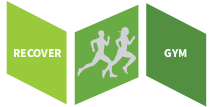External impingement of the shoulder (External impingement syndrome)
Rehab training of the injury
Rehab shoulder – Rehab back and pelvis
Description of external impingement in the shoulder
The muscular asymmetric impingement syndrome. Very many patients are diagnosed with impingement syndrome without actually having a problem with the shoulder muscles (supraspinatus or deltoids), and often by scanning or X-ray, it is revealed that the subacromial space between the upper arm and shoulder blade is too small. If this is detected, you may have surgery to “shave” a part of acromion, so again there is room for m. Supraspinatus during abduction (arm movement up and out away from the body to the side).
Often times space shortage or impingement signs may occur having at all to do with actual local shoulder problems. It is often illogical that a person has always had space and then from one day to the other, often because of overload, does not have the space in the subacromial pocket, so the arm can’t be abducted without pain. These conditions may be due to muscular asymmetry or because of another biomechanical factor that makes the shoulder unable to move freely.
You can divide these conditions into 3 types to be tested and treated:
1) Muscular asymmetry between an inhibited and weak serratus anterior muscle, and a hyper-tone and shortened pectoralis minor muscle. This is a very common condition, whereby the shoulder blade makes a forward rotation and hence a lowering of the acromion (the upper part of the shoulder blade), which causes space shortage. This condition must be examined first by testing m. Pectoralis minor and m. Serratus anterior.
Treatment of this condition
- Train m. Serratus anterior.
- Loosen pectoralis minor muscle with massage.
- Kinesiology tape.
- Pulsating and continuous ultrasound of 3MHZ 2 w / cm2 for 2 times 7.5 min.
- TNS for 5 min. at 10 Hz.
- K-Laser.
- Seek a therapist with expertise in the field who can treat with ART, MET, etc.
2) Biomechanical muscular asymmetry. When the arm is to be lifted, a corresponding counter contraction in the lower back should be made corresponding to the weight of the arm. An arm weighs +7 kilograms, which means that when the arm is abducted (carried outwards), the opposite sides of the muscle quadratus lumborum must make a corresponding contraction of what the arm weighs. The opposite muscle quadratus lumborum can only make this contraction sufficiently if the antagonistic (opposite) muscle quadratus lumborum (same as the shoulder problem) is in normal condition. If the muscle is hyper-tone (in a shortened condition), the opposite muscle quadratus lumborum can’t work and it will reduce the ability to move the arm outwards free of pain. This condition is examined by testing the same-side muscle quadratus lumborum for whether it is hypertonic.
Treatment of this condition
- Loosen m. Quadratus lumborum with massage.
- Pulsating and continuous ultrasound of 3MHZ 2 w / cm2 for 2 times 7.5 min.
- TNS for 5 min. at 10 Hz.
- Kinesiology tape.
- K-Laser.
- Seek a therapist with expertise in the field who can treat with ART, MET, etc.
3) Biomechanical neurological blockage. In order for opposite muscle quadratus lumborum to work as described in paragraph 2, the peripheral nervous system (outside the spinal cord) must not be compressed or clamped. Only a compression of lumbar nerve 1 (L1) the nerve that passes between L1 and L2 can either weaken or tighten muscle quadratus lumborum to such an extent that the relationship between how muscle quadratus lumborum works with the shoulder does not work. A 5 point palpation tests this condition.
Treatment of this condition
- Treatment of Lumbago Expert of L1 Dysfunction.
- Massage and stretching of the back.
- K-Laser.
If these methods have not helped after 3 treatments, the patient should consult a columnar therapist, chiropractor or osteopath to figure out a more specific form of therapy for the lumbar spine and the dysfunctional segment.
Rehab training of the injury
In rehab for the injury, you can minimize your problems and, if possible, completely remove your external condition, regardless of issue and cause.

Social Medier